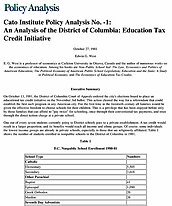On October 13, 1981, the District of Columbia Court of Appeals ordered the city’s elections board to place an educational tax credit initiative on the November 3rd ballot. This action cleared the way for a referendum that could establish the first such program in any American city. For the first time in the twentieth century all families would be given the effective freedom to choose schools for their children. This is a privilege that has been enjoyed before only by those families that can afford to “pay twice” for schooling, once through their conventional tax payments, and once through the direct tuition charge at a private school.
One out of every seven students currently going to District schools goes to a private establishment. A tax credit would result in a larger proportion, and its benefits would reach all income and ethnic groups. Of course, some individuals the lowest income groups are already in private schools, especially in those that are religiously affiliated. Table 1 shows the number of students enrolled in nonpublic schools in the District of Columbia in 1981.
Table 1
D.C. Nonpublic School Enrollment 1980–81
| School Type | Numbers |
| Catholic | |
| Elementary | 5,505 |
| Secondary | 3,618 |
| Other Parochial | |
| Baptist | 41 |
| Episcopal | 1,090 |
| Greek Orthodox | 20 |
| Muslim | 26 |
| Seventh Day Adventists | |
| Elementary | 70 |
| Secondary | 350 |
| General Private | 5,032 |
| Department of Human Services (Special Education) | 416 |
| Total D.C. Nonpublic Enrollment | 16,213 |
SOURCE: The Economic Communications Center of the Media Institute, Washington, D.C., 1981. Note: Total D.C. Public School Enrollment = 99,225 students.
The maximum tax credit under the District proposal is $1,200. Since there are no official figures on the current tuition costs in private schools in the District, it is not possible to obtain a precise estimate of the number and types of schools that would become accessible to present-day public school pupils. Some idea, however, may be obtained from recent figures on average tuitions paid in private schools across the United States. This information is to be found in the Current Population Survey, a monthly sample survey of approximately 50,000 households conducted by the Bureau of the Census. In the October 1978 supplement to the survey there was a question on private school tuitions. Table 2 presents the answers. It shows the number of private school students and the different tuition levels paid.
| Table 2 Tuition and Fees for Private School Students: Current Population Survey Sample, 1978 |
|||||||||
| Yearly Tuition and Fees | |||||||||
| less than$200 | $200 to $299 | $300 to $399 | $400 to $499 | $500 to $749 | $750 to $999 | $1000 to $1499 | $1500 to $1999 | $2000 or More | |
| Students | 1208 | 762 | 577 | 424 | 864 | 629 | 663 | 202 | 255 |
Source: Unpublished data, provided by Department of Commerce, Bureau of the Census.
The table suggests that the bulk of American school students in 1978 paid less than $1,200 in tuition. If conditions in the District are similar, the proposed $1,200 tax credit would enable families to gain access to most private schools, even if they were not prepared to pay extra amounts from their own incomes.
Insufficient space in existing independent schools need not be a barrier to families wishing to transfer; the promise of tax credits itself would encourage new schools to be set up fairly promptly to meet the demand. Meanwhile several existing schools could expand their capacity, by using mobile classrooms if necessary, or by opening “branch plant” schools.
About the Author

This work is licensed under a Creative Commons Attribution-NonCommercial-ShareAlike 4.0 International License.
